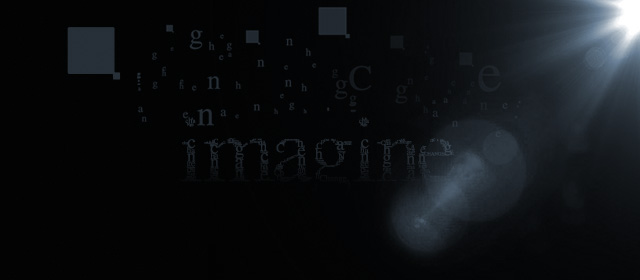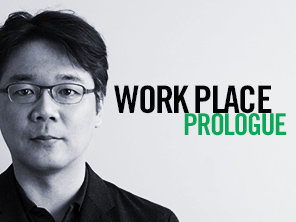WORK PLACE
TALK 1/3
The sense of sight has the priority and potential to control how people move: TOH ENJOE
April 6, 2015
Toh EnJoe is a popular writer who has won the Akutagawa Prize and numerous other awards both in Japan and abroad for his work. This edition presents a conversation between EnJoe and Ricoh researcher Hiromi Yoshikawa, discussing the work style of the future. Part one concerns the relationship between people's senses and technology. Their discussion, which focuses on the theme of how to make the invisible visible, sparks their imaginations.
The mysteriousness of the visual, which can be used for good or bad.
-
Yoshikawa:
I’m in charge of research efforts on the Theta 360-degree spherical-image camera, and its interlocked usage with airborne and head-mounted displays, so when I read your story, I found myself thinking that the fields we're researching might contribute somehow to the future society you've envisioned.
-
EnJoe:
The Theta camera basically has two lenses that can take a single image and make it look like a sphere, yes?
-
Yoshikawa:
Yes. Those two images are processed into a single spherical image, and what I've been working on is the color matching, so that you can't tell where the two images join. Since each lens takes images with different coloring, we've been researching how to smoothly align the colors. This area touches on vision, video, and imaging.
-
EnJoe:
Okay, so it sounds as if there's some mystery in the Theta images. When I think about the sense of sight, my head starts to hurt [laughs]. There's just so much I don't understand.
-
Yoshikawa:
You said it! [Laughs] But when it comes to sight, it's really on top in terms of the senses. For instance, people can feel as if their bodies have actually fallen over just by seeing imagery that makes it look that way.
-
EnJoe:
My understanding of sight was really simple: that what a person sees is basically a three-dimensional space with Cartesian coordinates, a rectangular coordinate system. But at the same time, I know that there are blind spots that we cannot see. And the things we can't see aren't just blacked out. Our brains are processing the scene so the background connects…
-
Yoshikawa:
Yes, yes. The things we see with our eyes are the images after processing.
-
EnJoe:
Given that the images are processed for correction, my head goes in a kind of sci-fi direction, where I'm thinking, "Hey, if we use the human perception system, couldn't we mess with people?" [Laughs]
-
Yoshikawa:
What I researched in the university was close to that, along the lines of inducing human behavior through vision. [Laughs]
-
EnJoe:
So you're bringing together perception and human movement? Well then, vision must really be a powerful sense.
-
Yoshikawa:
We can also input information through vision to influence what people perceive through their other senses, such as touch.

How to fill the gap between technology and corporeality
-
EnJoe:
It'd sure be convenient if Theta imaging technology could be introduced effectively into the workplace.
-
Yoshikawa:
At the current stage, I suppose it could be used for a remote videoconferencing system.
-
EnJoe:
Up to now, we've had teleconferencing systems, but it seems to me as if these haven't spread as widely as they could. For me, there's an odd time lag that happens during meetings that bugs me and that makes these systems hard to use.
-
Yoshikawa:
Yeah. You'd think that meetings would go more easily just with people being able to see each other, but I don't think that’s actually the case.
-
EnJoe:
Vision is a really dominant sense, but meetings don't actually go that well with just sight and sound. That makes this somehow more mysterious.
-
Yoshikawa:
There are several areas about this gap between corporeality, or embodiment, and technology that we've been aware of during our development of the Theta camera. For instance, some image noise is easily perceived by humans and some isn't. What is expressed in numbers won't always match what humans perceive. So we pay attention to the expression of color and other things.
-
EnJoe:
Yeah, illusions having to do with color are really something. Taking the same object and putting it in front of different backgrounds can make the object's color look different.
-
Yoshikawa:
Yes, that's the case. Digital cameras measure the numeric values of the brightness of the color of the whole image and optimize it, but even so, the image can look dark to the human eye.
-
EnJoe:
You can't fix it just by measuring. Afterward, the image or video taken by a camera might instead look overly clear to humans.
-
Yoshikawa:
Yes. Human vision does not have good resolution outside the center, and the periphery has almost no color resolution. But when you look at an image from a camera, the color and brightness are fully resolved throughout the whole thing.
-
EnJoe:
There's probably a discrepancy between the environment I actually see and images or video. And with images or video, it feels as if the point of focus, what draws our attention, gets messed up.
-
Yoshikawa:
So in the Theta camera image processing, the ultimate minor adjustment is with human sensibility. What fills in the gap at the end is the human eye.



















